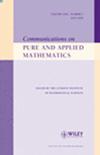Large deviations principle for the cubic NLS equation
IF 3.1
1区 数学
Q1 MATHEMATICS
引用次数: 4
Abstract
In this paper, we present a probabilistic study of rare phenomena of the cubic nonlinear Schrödinger equation on the torus in a weakly nonlinear setting. This equation has been used as a model to numerically study the formation of rogue waves in deep sea. Our results are twofold: first, we introduce a notion of criticality and prove a Large Deviations Principle (LDP) for the subcritical and critical cases. Second, we study the most likely initial conditions that lead to the formation of a rogue wave, from a theoretical and numerical point of view. Finally, we propose several open questions for future research.
三次NLS方程的大偏差原理
本文对弱非线性环境下环面上三次非线性薛定谔方程的罕见现象进行了概率研究。该方程已被用作数值研究深海流氓波形成的模型。我们的结果有两个:首先,我们引入了临界的概念,并证明了亚临界和临界情况下的大偏差原理。其次,我们从理论和数值的角度研究了最有可能导致流氓波形成的初始条件。最后,我们提出了几个有待进一步研究的问题。
本文章由计算机程序翻译,如有差异,请以英文原文为准。
求助全文
约1分钟内获得全文
求助全文
来源期刊
CiteScore
6.70
自引率
3.30%
发文量
59
审稿时长
>12 weeks
期刊介绍:
Communications on Pure and Applied Mathematics (ISSN 0010-3640) is published monthly, one volume per year, by John Wiley & Sons, Inc. © 2019.
The journal primarily publishes papers originating at or solicited by the Courant Institute of Mathematical Sciences. It features recent developments in applied mathematics, mathematical physics, and mathematical analysis. The topics include partial differential equations, computer science, and applied mathematics. CPAM is devoted to mathematical contributions to the sciences; both theoretical and applied papers, of original or expository type, are included.

 求助内容:
求助内容: 应助结果提醒方式:
应助结果提醒方式:


